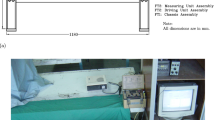Structural sheet metal materials are widely used in machine, aircraft, and rocketry building. Their strength under static tension (compression) is the primary characteristic and attribute in selecting materials for design developments. However, it is necessary to prioritize tension–compression fatigue tests for correct strength comparison under static and variable loads. The methodological difficulties associated with the need for the excitation of longitudinal vibrations in thin strip specimens with low stiffness limit the possibility of studying their fatigue strength under cyclic uniaxial tension– compression. The paper proposes a procedure for experimentally determining the fatigue strength of sheet materials under cyclic tension–compression under high-frequency loading. A special advantage of the procedure is the ability to ensure the proper stiffness of specimens without predeformation, which distorts the true experimental data inherent in the undeformed material. An algorithm was developed, and corresponding calculations were performed for a vibrating system, of which the specimen is a constituent part. The practical calculations are based on solving the problem of free longitudinal vibrations of a system of three dissimilar rods joined together at the free ends by common masses. Formulas for determining the rupture stress in specimens were obtained. Test trials of specimens of D16T and VT1-0 alloys confirmed the practical efficiency of the procedure. A resonant vibrating system was used, which was manufactured based on the results of the above theoretical calculations. In the design of this system, specimens with a cross-section of (0.5×5)×10–3 m had an active length of 48.2×10–3 m. The fatigue failure of specimens that occurred in the computational zone was controlled by the magnitude of the working stresses and the time of their occurrence. For example, a specimen of D16T alloy failed at a stress of 220 ×106 Pa after 8 ×106 loading cycles.




Similar content being viewed by others
References
P. Lin, Y. G. Hao, and B. Y. Zhang, “Planar anisotropy, tension-compression asymmetry, and deep drawing behavior of commercially pure titanium at room temperature,” J Mater Eng Perform, 28, 1734–1744 (2019). https://doi.org/10.1007/s11665-018-3646-6
T. M. Chinapareddygari, C. Ravishankar, and K. Thangaraj, “Stretchability of commercial purity titanium sheet,” Metall Mater Trans A, 50, 5602–5613 (2019). https://doi.org/10.1007/s11661-019-05417-4
Z. Hou, Z. Liu, and M. Wan, “An investigation on anisotropy behavior and forming limit of 5182-h111 aluminum alloy,” J Mater Eng Perform, 29, 3745–3756 (2020). https://doi.org/10.1007/s11665-020-04879-7
Y. Lee, S. Jung, and H. Baek, “Effect of Anisotropic plasticity on the prediction of formability of E-form magnesium alloy sheet,” Int J Automot Technol, 20, 1183–1193 (2019). https://doi.org/10.1007/s12239-019-0111-y
D. Banabic, F. Barlat, and O. Cazacu, “Advances in anisotropy of plastic behavior and formability of sheet metals,” Int J Mater Form, 13, 749–787 (2020). https://doi.org/10.1007/s12289-020-01580-x
C. Chermette, K. Unruh, and I. Peshekhodov, “A new analytical method for determination of the flow curve for high-strength sheet steels using the plane strain compression test,” Int J Mater Form, 13, 269–292 (2020). https://doi.org/10.1007/s12289-019-01485-4
V. I. Kalinichenko, O. G. Trapezon, and A. V. Rutkovskyi, “Determination of fatigue strength of VT1-0 titanium sheet under cyclic bending on prismatic specimens with surface layer modification,” Strength Mater, 54, 1027–1034 (2022). https://doi.org/10.1007/s11223-023-00477-9
A. D. Nikitin, A. A. Shanyavskiy, and N. N. Beklemishev, “Fatigue behavior of titanium alloys under very high cycle fatigue loading,” Inorg Mater Appl Res, 9, 75–81 (2018). https://doi.org/10.1134/S2075113318010185
X. Guo, Y. Yuan, and Y. Liu, “Crack propagation detection method in the structural fatigue process,” Exp Tech, 45, 169–178 (2021). https://doi.org/10.1007/s40799-020-00425-1
D. V. Babich and T. I. Dorodnykh, “Statistical model of the mechanism of fatigue failure of materials,” Mech Solids, 53, 591–600 (2018). https://doi.org/10.3103/S0025654418080137
I. A. Volkov, L. A. Igumnov, and D. N. Shishulin, “Numerical modeling of the fatigue life of structural steels under single-frequency and dual-frequency loading,” Mech Solids, 57, 86–101 (2022). https://doi.org/10.3103/S0025654422010162
K. Kamei and M. A. Khan, “Current challenges in modeling vibrational fatigue and fracture of structures: a review,” J Braz Soc Mech Sci Eng, 43, 77 (2021). https://doi.org/10.1007/s40430-020-02777-6
Author information
Authors and Affiliations
Corresponding author
Additional information
Translated from Problemy Mitsnosti, No. 3, pp. 37 – 47, May – June, 2023.
Rights and permissions
Springer Nature or its licensor (e.g. a society or other partner) holds exclusive rights to this article under a publishing agreement with the author(s) or other rightsholder(s); author self-archiving of the accepted manuscript version of this article is solely governed by the terms of such publishing agreement and applicable law.
About this article
Cite this article
Kalinichenko, V.I., Trapezon, O.G. & Trapezon, K.O. A Procedure for the Experimental Determination of the Fatigue Strength of Sheet Materials Under Uniaxial Tension–Compression. Strength Mater 55, 484–492 (2023). https://doi.org/10.1007/s11223-023-00541-4
Received:
Published:
Issue Date:
DOI: https://doi.org/10.1007/s11223-023-00541-4




